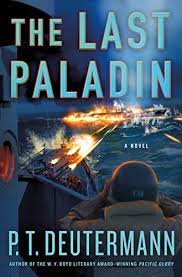By Capt. P.T. Deutermann USN (Ret.) St. Martins Press (2022)
Reviewed by Capt. C. Herbert Gilliland, USN (Ret.)
In his latest novel, P. T. Deutermann continues his successful mining of World War II themes. This time we follow the spectacular fortunes of USS Holland, a destroyer escort sent from convoy duty in the North Atlantic to an uncertain assignment in the western Pacific. In Deutermann’s braided narrative, alternate chapters are told by ship’s CO, Mariano deTomasi, and his XO, Ephraim Edmond “Eeep” Enright. This structure allows each to observe and comment on the other while working well as a team despite great differences in background and makeup. Lieutenant Commander deTomasi, though born in the US and a Naval Academy product, is by heritage and temperament pure Sicilian. Perceived disrespect by a senior officer will make him boil, and memories of seeing the crew of his first ship butchered at Pearl Harbor gives him a very personal passion for vengeance. He controls it, but “I want [the Japanese] all dead.” Enright’s PhD and brilliance in electrical engineering kept him a valuable civilian until, urged by his father’s grief at the loss of Enright’s older brother in combat in the Pacific, he insists upon active service. With his calmer logic, Eeep plays a Starbuck to his captain’s Ahab. His technical inventiveness is also important to the ship’s success.
They confront differences between the Pacific and the Atlantic theatres of war. The icy North Atlantic contrasts with the sweaty southern Pacific. But in terms of naval operations and combat, the major difference is in sheer size: the Pacific is thousands of square miles bigger, and the fleets involve hundreds or even thousands of ships sweeping across that area. When deTomasi indicates he feels neglected, the briefing officer tells him the upcoming operation will involve “eight hundred ships. …Don’t feel picked on, Captain, you’re just going to have to get used to the scale of what’s happening here in the Pacific.”
Half the size of a full destroyer, arriving months late and with no convoy to protect, Holland is initially greeted more as a nuisance than anything else. In the context of the huge fleet actions sweeping the Pacific, a lone DE can be easily overlooked. Still, Holland’s designation includes the word destroyer. Learning the Japanese are thought to have set up a picket line of submarines to give warning of the direction of an American task force. deTomasi gets Holland placed where he and his ship may be able to do what they do best—hunt submarines.
One of the Deutermann’s strengths here is how smoothly he incorporates essential details of anti-submarine warfare, as practiced at the time, into the action narrative. In the process of following Holland’s mission, the reader absorbs in passing such elements as the difference between depth charges and hedgehogs, the need to measure water temperature, and the tactical values of active versus passive sonar. Any reader with only a little prior knowledge will feel comfortably expert as he turns the pages. Having practiced multi-ship ASW with the British in the Atlantic, deTomasi brings that innovation to the Pacific as well. Another important U.S. Navy development at that time was the Combat Information Center (CIC), and Deutermann shows its importance throughout the novel, for ASW as well as other applications.
As in earlier work, Deutermann reminds readers that war is brutal and messy. A discussion of what happens inside when a submarine is destroyed reminds us that those are human beings inside, but Holland’s photographer gags while recording the “evidence”—distorted human remains– of a successful sinking.
Simply being at sea has dangers of its own, and after all, what is a good sea story without some rough weather? Between confrontations with Japanese submarines, Holland has to survive a typhoon with sixty-foot waves and winds that rip the anemometer right off its mount. Readers are treated to the full spectacle and fear that such a storm can provide, including coming into the “surreal seascape of the eye itself,” with the “boiling black clouds” of the opposite wall ahead. The rough sublimity of the storm has a counterpart or balancing moment of positive awe later, when Holland encounters Task Force 58. In Deutermann’s beautifully crafted passage, the formation of carriers, battleships, cruisers heavy and light, and lesser ships sweeps past the little DE at twenty-five knots.
If some readers might find Holland too successful against Japanese submarines to permit that willing suspension of disbelief upon which fiction depends, an author’s note at the end explains that The Last Paladin is inspired by the true story of USS England (DE-635). What he has produced is not a fictionalization of that story, but rather a different story whose plausibility relies upon the historical reality. If deTomasi and Enright had been real, is the implicit claim, their story might have been as well.
Once Holland has resolved deTomasi’s vendetta against Japan as embodied in its submarines, Deutermann makes it the target of a vengeful Japanese command. The result is a spectacular final shootout wrapped in a global framework. By the time we close the book, we have been treated not only to a violent short course in ASW, but also a good deal of surface and air action as well. Faithful Deutermann readers will not be disappointed; nor, I think will new ones.
Captain Gilliland is a professor emeritus form the U.S. Naval Academy.
P. T. DEUTERMANN is the author of many previous novels including Pacific Glory, which won the W. Y. Boyd Literary Award for Excellence in Military Fiction. Deutermann spent twenty-six years in military and government service, as a captain in the Navy and in the Joint Chiefs of Staff as an arms-control specialist. He lives with his wife in North Carolina.
The Last Paladin. By P.T. Deutermann (Manhattan, New York: 2022)


